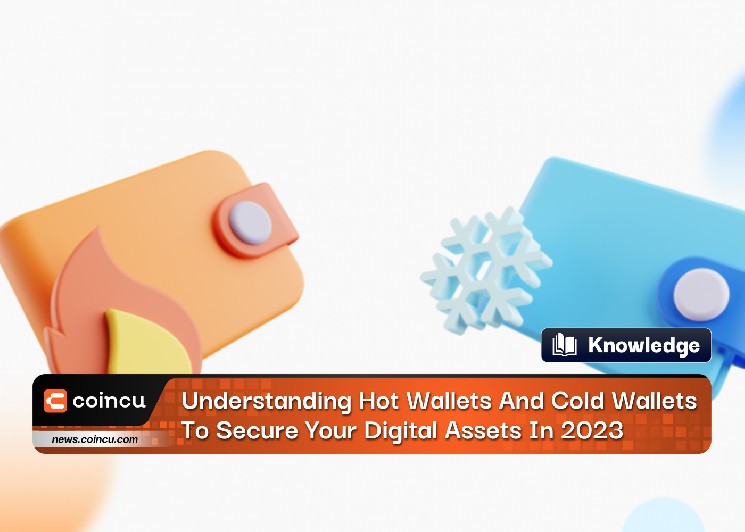Understanding Hot Wallets And Cold Wallets To Secure Your Digital Assets In 2023

Introduction

Cryptocurrency investors are always concerned about how to store their digital assets securely. With so many wallet options available, it is essential to understand the differences between them. Hot wallets and cold wallets are the most common means of storing cryptocurrencies.
Hot wallets are connected to the internet, making them more convenient for frequent trading but also more vulnerable to hacking. On the other hand, cold wallets are not connected to the internet, making them more secure but less convenient. Investors need to weigh the pros and cons of each option and choose the one that best suits their needs. By understanding the differences and similarities between hot and cold wallets, investors can optimize their storage options and better protect their digital assets.
Crypto Wallets
Cryptocurrency wallets are essential in the world of digital assets. They keep your digital assets safe by storing private keys necessary for crypto transactions. Private keys are like passwords that verify ownership and allow a crypto exchange. On the other hand, public keys are used to send crypto to others and act like usernames.
Understanding the basics of crypto wallets is crucial before diving into the differences between hot and cold wallets. Crypto wallets are designed to store private and public keys, which are made up of cryptographic strings of letters and numbers. These keys are responsible for successful crypto transfers into your wallet. Ultimately, understanding the differences between hot and cold wallets is essential for keeping your digital assets safe.
Hot Wallets

Hot wallets and cold wallets are the two main types of crypto wallets. The primary difference between them is their connectivity. Hot wallets are connected to the internet and are used for storing, sending, and receiving tokens. On the other hand, cold wallets are completely offline and are used for long-term storage of crypto assets.
Hot wallets are popular due to their ease of use and management. They are interconnected with phones, laptops, tablets, and other devices, making them convenient for daily use. Hot wallets come in a variety of types, including Coinbase Wallet, MetaMask, Trust Wallet, and Exodus Wallet.
MetaMask is an ecosystem-specific wallet that supports Ethereum-based tokens. Trust Wallet supports up to 65 different digital assets and is non-custodial. Exodus Wallet is software-based and supports more than 260 cryptocurrencies.
When choosing a wallet, it’s important to consider your specific needs and preferences. Hot wallets are a good option for those who need quick and easy access to their crypto assets. Cold wallets, on the other hand, are a good choice for those who prioritize security and long-term storage.
Pros and Cons
| Pros | Cons |
| Easy access | Vulnerable to digital attacks due to internet connectivity |
| More efficient and user-friendly interface | Some hot wallets are location specific |
| Free to use (with interest required for storage) | |
| Keeps money off centralized exchanges |
Cold Wallets

While hot wallets are connected to the internet, cold wallets are not. Cold wallets have become more popular following the FTX collapse of last year, prompting many to reconsider how they store their crypto and how to keep their assets safe.
Cold wallets are primarily hardware devices that look similar to a USB stick. They can be costly, ranging anywhere from $50 to $200. They function similarly to a paper wallet, maintaining your assets on your person, unconnected to the internet.
Cold wallets can exist in several different forms. Investors can use paper wallets, which maintain public and private keys printed on them, and can use a QR code to facilitate quicker transactions. Alternatively, hardware wallets are offline devices that store those very keys, while deep cold storage wallets are more like a safe or vault. They are mostly used for those who don’t need to access digital assets often.
Pros and Cons
| Pros | Cons |
| High security and protection of assets | Easy to lose |
| Little to no risk of hacking or theft | Expensive for average investors |
| Full possession of assets’ public and private keys | Requires technical understanding to use it effectively |
| Can be easily moved and transported | The complexity of use can be both a pro and con, aiding its safety but also making it difficult to use for some investors. |
Conclusion
As the world of digital assets continues to grow, cryptocurrency investors are increasingly concerned about how to store their digital assets securely. With so many wallet options available, it is essential to understand the differences between them. Hot wallets and cold wallets are the two most common means of storing cryptocurrencies.
Hot wallets are connected to the internet, making them more convenient for frequent trading but also more vulnerable to hacking. They are popular due to their ease of use and management. Hot wallets come in a variety of types, including Coinbase Wallet, MetaMask, Trust Wallet, and Exodus Wallet. Investors who need quick and easy access to their crypto assets may find hot wallets to be a good option.
On the other hand, cold wallets are completely offline and are used for the long-term storage of crypto assets. They have become more popular following the FTX collapse of last year, prompting many to reconsider how they store their crypto and how to keep their assets safe. Cold wallets are primarily hardware devices that look similar to a USB stick. They can be costly, ranging anywhere from $50 to $200. Cold wallets offer high security and protection of assets but also require technical understanding to use effectively. Investors who prioritize security and long-term storage may find cold wallets to be a good choice.
Ultimately, investors need to weigh the pros and cons of each option and choose the one that best suits their needs. By understanding the differences and similarities between hot and cold wallets, investors can optimize their storage options and better protect their digital assets.
DISCLAIMER: The Information on this website is provided as general market commentary and does not constitute investment advice. We encourage you to do your own research before investing.






 Bitcoin
Bitcoin  Ethereum
Ethereum  Tether
Tether  USDC
USDC  TRON
TRON  Dogecoin
Dogecoin  Cardano
Cardano  Bitcoin Cash
Bitcoin Cash  Chainlink
Chainlink  Monero
Monero  Zcash
Zcash  LEO Token
LEO Token  Stellar
Stellar  Litecoin
Litecoin  Hedera
Hedera  Dai
Dai  Cronos
Cronos  OKB
OKB  Tether Gold
Tether Gold  Ethereum Classic
Ethereum Classic  KuCoin
KuCoin  Gate
Gate  Algorand
Algorand  Cosmos Hub
Cosmos Hub  VeChain
VeChain  Dash
Dash  TrueUSD
TrueUSD  Tezos
Tezos  Stacks
Stacks  IOTA
IOTA  Basic Attention
Basic Attention  Theta Network
Theta Network  Decred
Decred  NEO
NEO  Synthetix
Synthetix  Qtum
Qtum  Ravencoin
Ravencoin  0x Protocol
0x Protocol  DigiByte
DigiByte  Nano
Nano  Zilliqa
Zilliqa  Holo
Holo  Siacoin
Siacoin  Numeraire
Numeraire  Waves
Waves  BUSD
BUSD  Status
Status  Enjin Coin
Enjin Coin  Pax Dollar
Pax Dollar  Ontology
Ontology  Hive
Hive  Lisk
Lisk  Steem
Steem  Huobi
Huobi  NEM
NEM  OMG Network
OMG Network  Bitcoin Gold
Bitcoin Gold  Augur
Augur  Ren
Ren  HUSD
HUSD